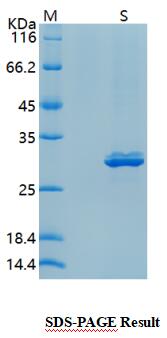Product Name :
CD158b2 Recombinant Protein Swiss-Prot :
P43628 Host :
E.coli Tag :
≥0.5mg/ml Amino acid Sequence :
HEGVHRKPSLLAHPGPLVKSEETVILQCWSDVRFQHFLLHREGKFKDTLHLIGEHHDGVSKANFSIGPMMQDLAGTYRCYGSVTHSPYQLSAPSDPLDIVITGLYEKPSLSAQPGPTVLAGESVTLSCSSRSSYDMYHLSREGEAHERRFSAGPKVNGTFQADFPLGPATHGGTYRCFGSFRDSPYEWSNSSDPLLVSVTGNPSNSWPSPTEPSSETGNPRHLH Restriction sites :
NdeI-XhoI Background :
Killer cell immunoglobulin-like receptors (KIRs) are type 1 transmembrane glycoproteins expressed by natural killer cells and subsets of CD4, CD8, and γδ T cells. Analogous to the diversity of their human leucocyte antigen class I (HLA Class I) ligands, the KIR genes are polymorphic and the content of the KIR gene cluster varies among haplotypes, although several "framework" genes are found in all haplotypes. The KIR proteins are characterized by the number of extracellular immunoglobulin-superfamily domains (2D or 3D) and by whether they have a long (L) or short (S) cytoplasmic domain. KIR proteins with the long cytoplasmic domain transduce inhibitory signals upon ligand binding via an immune tyrosine-based inhibitory motif (ITIM), while KIR proteins with the short cytoplasmic domain lack an ITIM and instead transduce activating signals. KIR proteins play an important role in the regulation of the immune response. Combinations of KIR and HLA class I variants influence susceptibility to autoimmunity and infectious disease, as well as outcomes of haematopoietic stem cell transplantation. Soluble :
PBS, 4M Urea, PH7.4 Purification&Purity :
Transferred into competent cells and the supernatant was purified by NI column affinity chromatography and the purity is > 85% (by SDS-PAGE). Storage&Stability :
Store at 4°C short term. Aliquot and store at -20°C long term. Avoid freeze-thaw cycles. Expression vector :
pet-22b(+) BiowMW :
~25kDa Note :
For research use only, not for use in diagnostic procedure. concentration :
≥0.5mg/ml
CD158b2 Recombinant Protein Swiss-Prot :
P43628 Host :
E.coli Tag :
≥0.5mg/ml Amino acid Sequence :
HEGVHRKPSLLAHPGPLVKSEETVILQCWSDVRFQHFLLHREGKFKDTLHLIGEHHDGVSKANFSIGPMMQDLAGTYRCYGSVTHSPYQLSAPSDPLDIVITGLYEKPSLSAQPGPTVLAGESVTLSCSSRSSYDMYHLSREGEAHERRFSAGPKVNGTFQADFPLGPATHGGTYRCFGSFRDSPYEWSNSSDPLLVSVTGNPSNSWPSPTEPSSETGNPRHLH Restriction sites :
NdeI-XhoI Background :
Killer cell immunoglobulin-like receptors (KIRs) are type 1 transmembrane glycoproteins expressed by natural killer cells and subsets of CD4, CD8, and γδ T cells. Analogous to the diversity of their human leucocyte antigen class I (HLA Class I) ligands, the KIR genes are polymorphic and the content of the KIR gene cluster varies among haplotypes, although several "framework" genes are found in all haplotypes. The KIR proteins are characterized by the number of extracellular immunoglobulin-superfamily domains (2D or 3D) and by whether they have a long (L) or short (S) cytoplasmic domain. KIR proteins with the long cytoplasmic domain transduce inhibitory signals upon ligand binding via an immune tyrosine-based inhibitory motif (ITIM), while KIR proteins with the short cytoplasmic domain lack an ITIM and instead transduce activating signals. KIR proteins play an important role in the regulation of the immune response. Combinations of KIR and HLA class I variants influence susceptibility to autoimmunity and infectious disease, as well as outcomes of haematopoietic stem cell transplantation. Soluble :
PBS, 4M Urea, PH7.4 Purification&Purity :
Transferred into competent cells and the supernatant was purified by NI column affinity chromatography and the purity is > 85% (by SDS-PAGE). Storage&Stability :
Store at 4°C short term. Aliquot and store at -20°C long term. Avoid freeze-thaw cycles. Expression vector :
pet-22b(+) BiowMW :
~25kDa Note :
For research use only, not for use in diagnostic procedure. concentration :
≥0.5mg/ml
Blocking peptide available as NCP0283P

 CD158b2 Recombinant Protein
CD158b2 Recombinant Protein 
 Datasheet
Datasheet COA
COA MSDS
MSDS SHIP
SHIP